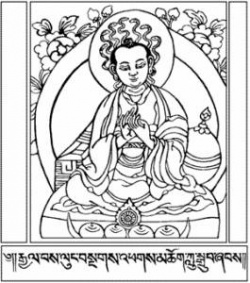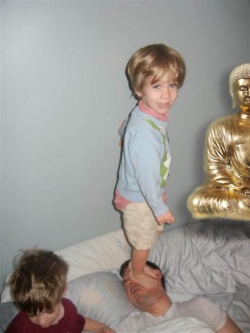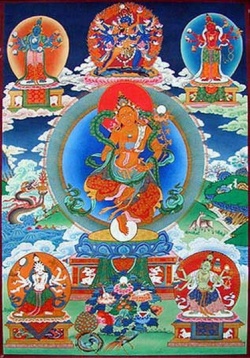Fear: Dealing with Disturbing Emotions
Dr. Alexander Berzin
Fear is one of the strongest impediments to achieving anything positive in life. As a confused state of mind, it is based on unawareness, especially concerning what it means to feel safe. With a wide array of both emergency and provisional methods, however, we can free ourselves from fear’s paralyzing grip.
Emergency Methods for Dealing with Fear
In Tibetan Buddhism, the female Buddha-figure Tara represents the aspect of a Buddha that protects us from fear. Tara actually represents the energy-winds of the body and the breath. When purified, she also represents the ability to act and to accomplish our aims. This symbolism suggests several emergency methods of working with the breath and with the subtle energies for handling fear.
The emergency methods derive from preparatory practices (preliminaries) that we do before meditating, studying, or listening to teachings. In and of themselves, these practices help to calm us down in emergencies, when we are extremely frightened or begin to panic. They also serve as the first steps to take before applying deeper methods. We may apply just one of them or practice all five in the following order:
Count the cycles of breathing with eyes closed, taking as the cycle the in and out-breaths, and focusing on the sensation of the breath coming in, going down, the lower abdomen rising, then falling, and the breath going out
Count the cycles of breathing with eyes half-opened, loosely focused, looking down at the floor, taking as the cycle the out-breath, a pause, and the in-breath, with the same focus as above, and after a while, adding awareness of the sensation of our bottoms touching the chair or floor.
Reaffirm the motivation or goal of what we wish to achieve (becoming more calm) and why.
Imagine that the mind and energy come into focus like the lens of a camera.
Without counting the breath, focus on the lower abdomen rising and falling while breathing and feeling that all the energies of the body are flowing harmoniously.
What Is Fear?
Fear is a physical and emotional uneasiness felt about something known or unknown, over which we feel we have no ability to control, handle, or bring to the result that we wish. We want to be rid of what we fear, and thus there is a strong repulsion. Even if the fear is a general anxiety, without a specific object that we fear, still there is a strong wish to be rid of an undefined “something.”
Fear is not simply anger. Nevertheless, similar to anger, it entails an inflation of the negative qualities of the object we fear and an inflation of “me.” Fear adds to anger the mental factor of distinguishing (recognition) that we cannot control or handle the situation. We then pay attention to what we fear and to ourselves in terms of that way of distinguishing. That way of distinguishing and paying attention may be accurate or inaccurate.
Fear Is Accompanied by Unawareness
Fear is always accompanied by unawareness (ignorance, confusion) of some fact of reality - either not knowing it or knowing it in a manner that contradicts reality. Let us consider six possible variations.
(1) When we fear that we cannot control or handle a situation, our fear may be accompanied by unawareness of cause and effect and how things exist. The conceptualized objects of our fearful way of paying attention to ourselves and what we fear are:
A solidly existing “me” – someone who, by his or her power alone, should be able to control everything, such as our child not getting hurt
A solidly existing “thing” – something existing on its own and not influenced by anything else, that we should be able to control by our own efforts alone, but we are unable to do so because of some personal inadequacy.
These are impossible ways of existing and impossible ways in which cause and effect work.
(2) When we are afraid that we cannot handle a situation, the accompanying unawareness may be of the nature of the mind and impermanence. We fear that we cannot handle our emotions or the loss of a loved one, we are unaware that our experiences of pain and sadness are merely the arising and cognizing of appearances. They are impermanent and will pass, like the pain of a dentist drilling out teeth.
(3) Our fear of being unable to handle a situation may be fear that we cannot handle it by ourselves. It may also entail the fear of being alone and loneliness. We think that we can find someone else who can alleviate the situation. The conceptualized objects here are
A solidly existing “me” – someone who is incompetent, inadequate, not good enough, and who can never learn
A solidly existing “someone else” – someone who is better than me and who can save me.
This is another form of unawareness of how others and we exist and unawareness of cause and effect. It may be accurate that we do not have sufficient knowledge now to be able to handle something, such as our car breaking down, and someone else may have that knowledge and be able to help us. However, that does not mean that, through the workings of cause and effect, we cannot learn.
(4) When we are afraid of someone, for instance our employers, we are unaware of their conventional natures. Our employers are human beings, with feelings just as we have. They want to be happy, not unhappy, and want to be liked and not disliked. They have lives outside the office and these affect their moods. If we can relate to our employers in human terms, while remaining mindful of our respective positions, we will have less fear.
(5) Similarly, when we are afraid of snakes or insects, we are also unaware that they are sentient beings, just like ourselves, and want to be happy and not be unhappy. From a Buddhist point of view, we may be unaware of them as the current manifestation of an individual mental continuum that does not have an inherent identity as one species or another. We are unaware that they could even have been our mothers in previous lives.
(6) When we are afraid of failure or sickness, we are unaware of our conventional natures as limited samsaric beings. We are not perfect and of course we will make mistakes and sometimes fail or fall sick. “What do you expect from samsara?”
Feeling Safe
From a Buddhist perspective, to feel safe does not entail:
Turning to an omnipotent being who will protect us, since omnipotence is impossible
Even if a powerful being could help us in some way, needing to please that being or make an offering or sacrifice in order to receive protection or help
Becoming omnipotent ourselves.
To feel safe, we need, in the following order:
To know what we fear and to recognize the confusion and unawareness underlying it
To have a realistic idea of what it means to handle what we fear, especially in terms of ridding ourselves of the underlying confusion
To evaluate our abilities to handle what we fear, both at the moment and in the long run, without under or overestimating ourselves, and accepting the present stage of our development
To implement what we can do now – if we are doing it, rejoice; and if we are not doing it, resolve to do it to the best of our present abilities and then actually try to do it
If we cannot handle it completely now, to know how to develop to the point at which we can handle it completely
To aim and work for reaching that stage of development
To feel that we are going in a safe direction.
The above seven steps describe what Buddhism calls “taking safe direction” (taking refuge). It is not a passive state, but an active one of putting a safe direction in our lives – the direction of working, in a realistic manner, on ridding ourselves of our fears. Consequently, we feel safe and protected because we know that we are going in the positive and correct direction in life that will enable us eventually to be rid of all problems and difficulties.
A Realistic View of How to Handle Frightening Situations
We need to remember:
Whatever happens to our loved ones or us is the ripening of a huge network of individual karmic forces, as well as historical, social, and economic forces. Accidents and other unwished for things will happen and we cannot protect our loved ones from them, no matter how careful we may be and how much we advise them to be careful. All we can do is try to give sound advice and wish them well.
To overcome accidents and fear, we need to gain non-conceptual cognition of voidness. Remaining totally absorbed in voidness, however, is not like sticking our heads in a hole in the ground. It is not running away from fear, but is a method for eliminating the unawareness and confusion that cause our karma to ripen into unwished for things and that cause us to have fear.
In working with the non-conceptual cognition of voidness to purify ourselves of our karma, we will still experience accidents and fear all the way up to the stage of liberation from samsara (arhatship). This is because the nature of samsara is that it goes up and down. Progress is not linear; sometimes things go well and sometimes they do not.
Even once we attain liberation as an arhat, we will still experience accidents and things that we do not want to happen. However, we will experience them without pain or suffering and, because we are free from all disturbing emotions and attitudes, without fear. It is only at the stage of arhatship that we can fully handle all our fears in the deepest manner.
Only when we reach enlightenment do we no longer experience accidents or anything unwished for happening. Only a Buddha is fearless in proclaiming:
His or her own realizations, of all good qualities and skills
His or her own true stoppings of all obscurations preventing liberation and enlightenment
The obscurations that others need to rid themselves of to attain liberation and enlightenment
The opponent forces that others need to rely upon to rid themselves of them.
Provisional Methods for Dealing with Fear
Reaffirm going in a safe direction of life, through the seven steps outlined above.
When facing a frightening situation, such as a test for cancer, imagine the worst scene happening and imagine what would happen then and how we would handle it. This helps to dispel the fear of the unknown.
Before undertaking something, such as reaching the airport on time to catch a plane, have several solutions prepared so that if one fails, we are not left with the frightening scenario of having no other way to achieve our goal.
As Shantideva taught, if there is a frightening situation and we can do something about it, why worry, just do it. If there is nothing we can do, then why worry, it won't help.
Since we will experience fear and unhappiness all the way to liberation, we need to focus on our minds as being as deep and vast as the ocean and, when fear or unhappiness arises, let it pass like a swell on the ocean. The swell does not disturb the calm and quiet depths of the ocean.
If we have built up sufficient positive karmic force (merit) from our constructive actions, we can be confident of continuing with a precious human body in future lives. The best protection from fear is our own positive karma, although we need to bear in mind that the nature of samsara is that it goes up and down.
In the face of a frightening situation, we may commission or perform ourselves a ritual requesting the aid of a Dharma protector or a Buddha-figure such as Tara or the Medicine Buddha. Such figures are not omnipotent beings who can save us. We request and open ourselves to their enlightening influence, so that it may act as a circumstance to ripen the karmic forces from our previously committed constructive actions that might not otherwise have ripened. A more secure effect is for their enlightening influence to act as a circumstance to ripen into trivial inconveniences the karmic forces from our previously committed destructive actions that might otherwise have ripened into serious obstacles preventing success. Thus, instead of being frightened of difficulties, we welcome them as “burning off” negative karmic forces.
Reaffirm our Buddha-natures. We have the basis levels of deep awareness to understand difficult and frightening situations (mirror-like deep awareness), to recognize the patterns (equalizing deep awareness), to appreciate the individuality of the situation (individualizing deep awareness), and to know how to act (which may include realizing there is nothing we can do) (accomplishing deep awareness). We also have the basis level of energy actually to act.
Reaffirm that having Buddha-nature means that we have the basis for all good qualities complete within us. In Western psychological terms, these qualities may be conscious or unconscious (we may be mindful of them or not, and they may be developed to different degrees). Often, we project the unconscious qualities as a “shadow.” Because the unconscious is the unknown, the tension of being unaware of it manifests as fear of the unknown and thus fear of our unknown unconscious qualities. Thus, we may identify with our conscious intellectual side and ignore or deny our unknown, unconscious, emotional feeling side. We may project the emotional feeling side as a shadow and be frightened of others who are very emotional. We may be afraid of our own emotional side and have anxiety about being out of touch with our feelings. If we identify with our conscious emotional feeling side and deny our unconscious intellectual side, we may project the intellectual side as a shadow and be intimidated by those who are intellectual. We may be afraid to try to understand anything and feel anxiety about being intellectually dull. Thus, we need to reaffirm both sides as complete within us, as aspects of our Buddha-natures. We may visualize the two sides embracing each other in the form of a couple, as in a tantra visualization, and feel that we are the complete couple ourselves, not just one member of the pair.
Reaffirm another aspect of our Buddha-natures, namely that the nature of the mind is naturally free of all fears and so experiencing fear is merely a fleeting superficial event.
Reaffirm yet another aspect of Buddha-nature, namely that we can be inspired by others to have the courage to face frightening situations.
Summary
When we are overwhelmed with fear, if we remember these methods for dealing with it, we will be able to quiet down and deal in a realistic way with whatever situation seemed frightening.









